
Howdy folks! Welcome back to the Bronze Age. Join me for the next stage of our trip!
Roll Call (You can see everything published this month HERE)
- Action Comics #388
- Batman #221
- Brave and the Bold #89
- Challengers of the Unknown #73
- Detective Comics #399
- Flash #196 (Reprints, won’t be covered)
- Flash #197
- G.I. Combat #141
- Justice League of America #80
- Showcase #90
- Superman #226
- World’s Finest #193
Bonus!: Star Hawkins (for real this time)
Bolded entries are covered in this post, the others will be covered soon.
Challengers of the Unknown #73
 Cover Artist: Nick Cardy
Cover Artist: Nick Cardy
Writer: Dennis O’Neil
Penciler: George Tuska
Inker: George Tuska
Editor: Murray Boltinoff
Now this is more like it. While it’s got its weak points, this is a Challengers issue, hitting the notes that a good story of theirs should. Interestingly, the editor includes a short missive in the letter column about the rotating cast of artists that the book has featured over the last few months, promising that they have finally settled on someone that they think is right for the Chals. I have to say, George Tuska does a fine job with this story. The art is good, but the layouts and general design is particularly impressive. This is, of course, all the more bittersweet, since the book ends with the next issue.
This Challengers adventure begins with an out of control space capsule careening earthward and splashing down in the ocean. It is immediately picked up by waiting support crews and landed on an aircraft carrier, which is depicted only in silhouette as dawn breaks over the horizon in a rather nice panel.

The naval crew find the pilot dead, not killed by the force of reentry or anything of that sort, but strangled while trapped alone in a sealed craft 10,000 miles from earth! Dun dun DUN! Now that’s a pretty good problem for the Challengers, something bizarre and inexplicable. Again, Tuska’s art conveys the message in an interesting way. Just the image of that arm sticking out of the capsule and the startled faces of the officers tells you just about everything you need to know.

We pick up with the Challengers who are camped out in Ace’s New York apartment, and we also pick back up with the old argument. Red is an insufferable jerk to Corinna, again. At this point, his boorishness is getting old, but the highlight of this scene is the return of the Prof! He’s walking with a cane, but he is walking, and he’s back to his old self! That’s a very pleasant surprise, as I rather imagined he’d been written out of the series permanently.

Of course, this prompts Red to begin picking on Corinna, wanting to throw her off the team. Also predictably, Rocky steps in to defend her, since the lady Challenger apparently can’t stand up for herself. This leads the two to come to actual blows, where both show off their expertise, the strongman throwing Red around the place, and the acrobat flipping and rolling to stay in the fight. It’s a nice sequence, even if this whole love/hate subplot is getting old.

Ace arrives to break up the fight and inform the team about their mission. Arriving at an air force base, the Chals meet a fellow named Major Cheever, an astronaut who will be their liaison during their visit. Here is where things take a turn for the strange and we run into one of the only real problems with this issue. Corinna suddenly receives “weird vibrations” and informs us that she is totally a medium, and she has absolutely been one all along. This is definitely not a sign that O’Neil is making her character up as he goes along. This is the problem with Corinna. She’s really vaguely defined, and there is just no unifying concept behind her.
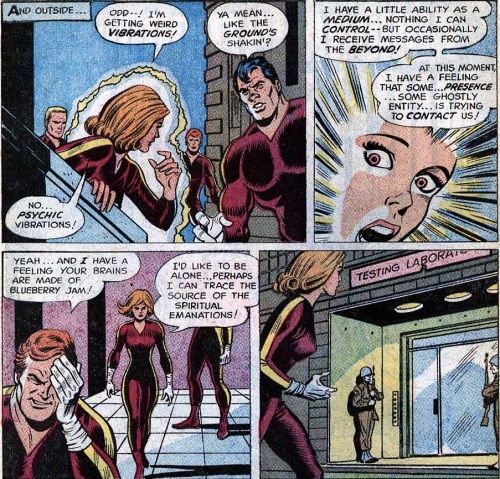
Well, she runs off to find privacy to employ the ability that she’s absolutely always had, and she brilliantly decides that the base vacuum chamber is the best place. I’m sure you can see what’s coming. Of course, someone slams the door on her and turns on the mechanism, sucking the air out of the chamber. I’m sorry Corinna, but it’s things like this that make it seem like Red, as much of a jerk as he is, might just have a point. I’m not convinced you’re really Challengers material.

She’s rescued by Rocky, who shatters the shatter-proof glass in desperation. Corinna recovers, but the two guards who had been watching the facility have been shot! Ace does some quick thinking and realizes that the guards have been staged to make it look like a murder/suicide, but apparently the killer is a moron, as the supposed suicide was shot in the back. That’s not really all that much of a deduction there, Ace. I guess you’re not exactly Sherlock Holmes, eh?

Later, the Chals hold a seance to contact whatever is involved in this mystery, an idea that, unsurprisingly, Red opposes. Ace overrules him, and they actually manage to make contact with…something, an otherworldly spirit, but just as it is about to spill the beans, someone throws a grenade in the window!

The team scatters, but Rocky manages to smother the blast with a mattress, adding a nice line that it “takes more than a lousy hand grenade to do in a lunk like me.” It’s a good moment.

 The Chals head to the base and Ace, Red, and Corinna prepare to head up towards the Moon so they can challenge (sorry!) whatever is causing these problems. They join Major Cheever, after Ace gives a nice little speech about how much still remains unknown about the cosmos to a dubious officer.
The Chals head to the base and Ace, Red, and Corinna prepare to head up towards the Moon so they can challenge (sorry!) whatever is causing these problems. They join Major Cheever, after Ace gives a nice little speech about how much still remains unknown about the cosmos to a dubious officer.
However, in space, the team is attacked by…Major Cheever! Just then, a strange energy creature materializes in the capsule. I really like the design for this being, amorphous and vaguely defined, fitting for an energy lifeform. Having touched Corinna’s mind, the creature, named Machu, feels a connection towards her. It resists Cheever’s orders, and it tells its story. Apparently its race long ago came to the Moon looking for a new world to call their own. This being was the guardian of his people, but because he failed in his duties, they were destroyed. With his dying (what? breath? do energy beings breath?)…something, their leader cursed Machu, saying that he must stay in the cold emptiness of space until he destroyed two evil creatures as recompense for his failure.

It seemed that the “wild black” drove Cheever insane, and his meeting with Machu convinced him that space was too dangerous to humanity. He has become certain that the alien life that man will inevitably encounter, like this energy being, will corrupt humanity and eventually destroy them. Thus, he has manipulated Machu’s grief to sabotage the space program. It was this creature that strangled the astronaut, and now Cheever sics him on the Challengers. Yet, Machu has learned from his contact with our heroes, and he realizes that his understanding of man has been flawed. He attacks the Major instead, in a really nicely drawn sequence, which ends with the astronaut’s death.


To atone for his mistakes, having killed an innocent man, Machu decides to end his own life to complete his mission. Shocked, the Challengers begin their descent, coming back down to Earth and the end of their adventure.

So, this is a good story, just the right kind of tale for the Challengers, where they encounter something new and unknown and solve their problems with more than just brute force. It is really only weakened by two things. The first, as already noted is the fact that O’Neil just can’t decide who he wants Corinna to be. Yeah, the whole mystical element of the last issue does lay some groundwork for this sudden turn at being a medium, but it is just too much of a stretch. If she hadn’t been shoe-horned into the team in the first place, she might have been able to develop more organically. The second issue with the issue (sorry again!) is that our villain, Major Cheever, just shows up out of nowhere. A bit more setup would have done wonders for the effect of the story. As is, I like the mystery at the core here, I like most of the character work, and I really enjoyed the art. The Challengers are probing the unknown, and that’s the way it should be. The story just needs a little more room to breathe. I’ll give it 3.5 Minutemen.
Detective Comics #399
 Cover Artist: Neal Adams
Cover Artist: Neal Adams
Writer: Dennis O’Neil
Penciler: Bob Brown
Inker: Joe Giella
Editor: Julius Schwartz
“Panic By Moonglow”
Writer: Frank Robbins
Penciler: Gil Kane
Inker: Vince Colletta
Editor: Julius Schwartz
This is a solid, enjoyable Batman tale, though definitely still a product of this intermediate era, like the other story of this month. It gives you a look at Batman’s brilliance as a detective, as well as his mastery of martial arts. It’s nice to have this balanced portrayal, though Bob Brown’s art doesn’t quite manage to match the action. It’s always obvious when you have someone who doesn’t really know how to fight drawing a fight scene. For super powered demigods slugging each other, that isn’t necessarily that big of a deal, but when you’re supposed to be seeing a martial artist in action, the results can look comical and awkward.
Nonetheless, the issue is fun, and it follows a pretty exciting cover. I like its layered effect, Gordon’s arm, Batman crouched and ready, and the murderous Master Kahn (“Khhhhhhhhaaaaaaannnnn!”) behind him. The story opens with Batman and a local martial arts master putting on a demonstration of close combat techniques for the police. Now, clearly this is a bit of a holdover from the “policeman’s friend” Batman, but it isn’t too jarring.
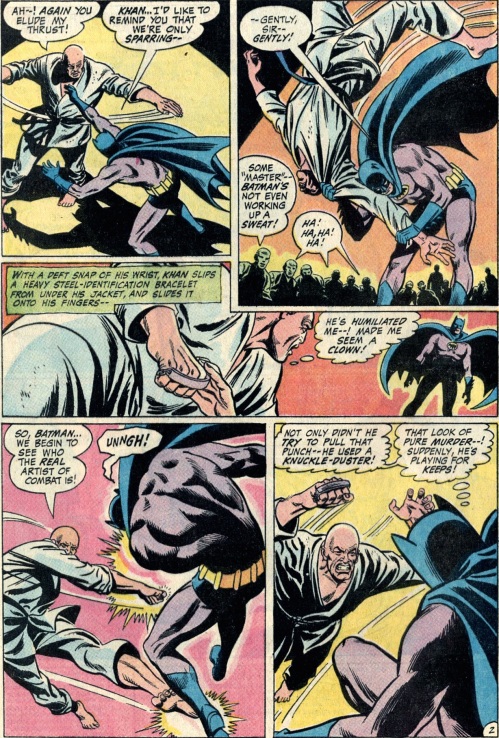
The pair begin to spar, and the Masked Manhunter embarrasses the hot tempered Master Khan, and in response, the fighter pulls out a knuckle-duster and tries to put the hero down. Batman flat out cold-cocks him, knocking the fellow unconscious.

This prompts a fit of whining from a fellow named Arthur Reeves, who is the “mayor’s new public works coordinator,” and something of a red herring in this story. He doesn’t serve much of a purpose other than to add some texture and lightness to the tale, but I suppose he is rather entertaining, being something of a bureaucratic antagonist for Batman. Most notably, he gives us a funny scene where, after complaining that the Dark Knight shouldn’t be trusted because he wears a mask, and no-one who “pretends to serve the public has any reason to stay hidden.” In response, Bats simply lifts off the fellow’s toupee. It’s a legitimately funny moment., and if not entirely fitting for Batman, it doesn’t seem entirely out of character either. Even the grim avenger of the night might happily puncture the inflated ego of such a stooge. It’s also nice to see a sign that not everyone in power approves of the Dark Knight’s crusade.

Batman gets back to his crime-fighting efforts, and a month later, he answers the Bat-signal to discover that Khan’s dojo has burned down, and he seems to have died in the blaze. “Seems to,” being the operative phrase, and I’m sure we can all see what’s coming. Later, Batman and Gordon are called to a seance (a lot of that going around this month!) with the claim that vital information will be revealed to them. On the way, a gunman tries to ventilate them with a Thompson, but the Caped Crusader manages to take him out by playing possum.

Heading for the seance once again, and now knowing that it is somehow involved in this setup, Batman and the Commissioner meet a former hood named “Big Dough” Joe, who claims to have reformed. It ends up being another red-herring, but it helps this story to feel a bit more fleshed out, and there is a good touch of humanity in this fellow’s brief appearance. He’s trying to turn his life around, even thanks Gordon for putting him away, and yet we can’t help but be suspicious of him.

Well, during the seance, a “medium” named “the Great Dilbert” (really dude? That’s going to be your stage name?) puts on a show that features the “spirit” of Khan swearing vengeance on Batman from beyond the grave. Interestingly, his plan is not to kill the Masked Manhunter, but to embarrass him as the martial artist himself was, by killing Gordon! In response, the pencil-necked geek, Reeves, insists (how does he have any say in all of this?) that the Commissioner be locked in a vault and carefully protected where no-one can get to him. In a solid display of the Dark Knight’s skills, the hero sneaks in disguised as a cop (somehow with his entire costume hidden under the uniform, cowl and all!), and then deduces that the Gordon they are protecting is a fake!
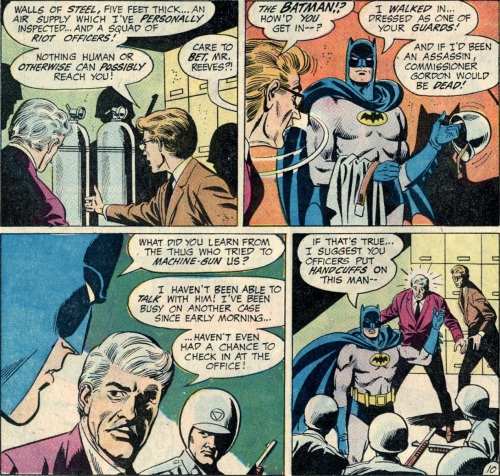
The imposter is revealed to be “Dilbert,” but just as he is preparing to confess, he dies mysteriously! It seems his partner poisoned the mask he was wearing to ensure his silence. His dying “words” are ‘D..do..j..jo…” which, of course makes everyone suspect our formerly felonious friend. The Caped Crusader has other ideas though, realizing that what the fellow actually said was “dojo.”

He arrives at the ruined martial arts studio and discovers (gasp!) a very much alive Khan. We get a nice, dramatic reveal as Batman confronts his adversary and they begin a duel, torch vs. katana, and then hand to hand. It is an admittedly short fight. Batman just straight-up outclasses this clown, and he drops him in relatively short order.


This issue is a good, solid Batman adventure, with a reasonable mystery, some action, and plenty of personality. It’s a pleasant read, if a bit underdeveloped. After all, it’s only 14 1/2 pages. I think just another page of background or attention for Khan could have added a good deal to the whole thing, but nonetheless, it’s a fun story. I really do love that panel of Batman silently de-toupee-ing the weasel Reeves. I’ll give it four Minutemen!

“Panic By Moonglow”
Let’s see if Robin performs any better in this adventure than in the first part. As we remember, he was knocked out with a head-blow (Holy Hannah! How did I miss that! I’m going to retroactively add it to the list!), and we join him this issue as he comes to, looking up into the face of Zukov, the Russian scientist who was lecturing at the university. The quarantine is still in effect, so the good doctor offers his quarters for Robin’s recuperation, but the Teen Wonder has more on his mind than rest.

He is suspicious of Zukov, and he eavesdrops on his host. It’s a good thing too, because the husky huckster is in cahoots with communist spies! He lets them out of a trap door, and orders them to take out the “sleeping” sidekick. Robin is way ahead of them, though, and he takes off to prevent the rest of their plan from coming together. Apparently, they poisoned the student from the last issue with the aid of the soap the Teen Wonder discovered, but that was just to set the stage for their next move. Once the boy dies, the Russians will use this to bury NASA under a storm of bad publicity for releasing a cosmic plague on the planet!

Robin takes off to retrieve the Moon rock as evidence, and an over-eager National Guard sentry takes a shot at him! This is a really interesting bit of synchronicity, given the violent events at Kent State this month, especially considering that this issue would have been written well before that happened. Clearly, there was tension in the air during this year.

Well, despite the sentry’s shot, our hero manages to reach the building’s roof, and the Russian agents attempt to intercept him. Here Robin gets a better showing than the last issue, taking out two of his opponents in appropriately acrobatic fashion as he dangles from a rope.

Inside, he confronts Zukov, who has a tiny, hand-held laser, and it actually functions somewhat like an actual laser, rather than the variety most commonly found in comics. Unfortunately, Robin has another unimpressive moment, as, startled by a shot, he crashes through the skylight and snags his cape on the edge, leaving him a sitting duck for the spy. Obligingly, Zukov begins to monologue, graciously explaining his plan, and Robin uses the time to free himself, and, in an admittedly nicely drawn sequence, catch his rope and slide down into the darkened interior of the building.

A brief game of cat and mouse follows, and Zukov kills causes his own demise by slicing through one of the supports of the lunar lander module on display there, causing the vehicle to collapse and crush him. Fortunately, the good guys find the antidote and rescue the poisoned dweeb, and all’s well that ends well.

All-in-all, this is a fair back-up story, and it is definitely an improvement over the first half. We get to see Robin do some pretty cool stuff, using his brains and his training, and even his goof in this issue leads us to a good sequence that shows off his skills. The Russian plot is actually fairly clever and subtle, by comic book standards, and the Cold War tensions, as well as the surprisingly apt presage of campus-bound violence makes this issue rather interesting in retrospect. I’ll give it 3.5 Minutemen.

The Flash #197
 Cover Artist: Gil Kane
Cover Artist: Gil Kane
Writer: Mike Friedrich
Penciler: Gil Kane
Inker: Vince Colletta
“To the Nth Degree”
Writer: Robert Kanigher
Penciler: Gil Kane
Inker: Vince Colletta
This is a fun all around issue of the Flash, especially considering how rough most of the issues I’ve read have been. This set of tales takes advantage of the character, the supporting cast, and the powers. Sadly, no ‘Lightning the Speedy Hound.’
We start with Barry Allen working in his police lab with his long-time partner (who we’ve never seen before, of course), who is working on cracking a case. The pair have worked together so long that they’ve developed their own non-verbal shorthand. With a series of gestures they hold an entire conversation, with Barry rubbing his nose to indicate approval.

Just then a call comes in that “Ice” King is in the middle of another robbery. This is not a new supervillain, but a criminal of unlikely and fairly preposterous cleverness. Apparently, Central City has been hit by heavy snowfall, and this creative crook has been making his getaways on skis to avoid the police on treacherous roads.

It’s silly, but it is quite fun, and Flash tries several inventive tactics to catch this chilly criminal. Of course our hero could simply super speed punch this fellow into the next timezone, but it fits the character that he’s challenging himself to find creative, relatively non-violent solutions. He finally chops the fellow’s skis into matchsticks with super speed, but the thief has a heart attack as he tumbles into the snow! Or at least, that is how it seems.

Conveniently, there is an ambulance on hand, and they load him up and rush off. Shortly Flash realizes that this was another clever plan by the “Ice” man (one wonders how long this run-of-the-mill crook could have operated in Central City before Captain Cold decided to show him who the real ice king is…). Yet, this revelation comes from Flash’s crime lab partner, Charlie Conwell, and without thinking, Flash responds with the same gesture used by Barry Allen!

The Scarlet Speedster tries to cover the gesture by faking a sneeze, but a seed of doubt is planted! Nonetheless, the thief made good his getaway. We’re next treated to a charming little scene between Barry and Iris. This little glimpse of their domestic life is just plain lovely. This the texture and joy that’s lost because DC has apparently become terrified of marriage, not to mention the moral aspect of that loss. Anyway, Mrs. Flash is filling in for the Picture News’s drama critic, and she encourages her heroic husband to take up amateur acting. He agrees and auditions for a production of Hamlet being put on by the police department. It’s a nice bonus that the minor supporting character Dexter Myles, former shakespearean actor, is directing the play. Barry snags the part of Horatio, and already we’re seeing lots of Flash’s life outside of the mask, which makes for a fun expansion of his world and character.

Unfortunately, the cast all comes down with the flu right before opening night, but the Fastest Man Alive believes that “the show must go on,” so he decides to play all of the parts himself at super speed! We get another of Kane’s odd collage panels, but this one actually works quite well, perhaps because all of the different elements work together to tell a single story. After finishing his performance, the Crimson Comet is suddenly struck by that virus that hit everyone else, just as “Ice” King and his cronies show up, dressed as policemen, to raid the box office. They decide to snuff the Flash because he seems helpless, but our hero super accelerates his metabolism so that the illness runs its course in moments. It makes sense, in a comic book-y kind of way, and he’s able to roll with his assailants’ punches long enough to get back on his feet.

He takes out the gang in a nice panel, and then he heads home to the ministrations of his caring wife. Yet, he’s interrupted in his recuperation by his old friend Charlie! Knowing him to be suspicious, the Scarlet Speedster uses his speed to appear as the Flash and as a bed-ridden Barry. This convinces the other scientist that he must have been wrong about the hero’s secret identity, and he leaves Barry to recover.

This was a fun, light-hearted story, which fits the Barry Allen Flash quite well. After all, he’s not driven to be a hero by loss like Batman (despite later retcons); he does it because it is the right thing to do and, to a degree, for the fun! He, like Aquaman, is an adventurer, but unlike the Sea King, his world is, for all of its color and charm, relatively normal. Thus, it is fitting that we see a community of characters growing up around the Flash.

For all of their silliness, that is something that the Silver Age adventures of the Scarlet Speedster accomplished quite well. Central City is an interesting setting, and Barry Allen is much more a part of it than other characters, like Bruce Wayne/Batman, are traditionally part of theirs. Gotham may be central to who Batman is, but Bruce Wayne is a man apart, while Barry Allen is working with the police department, taking up hobbies, and living a domestic life. It makes him a character that I’ve always really loved, even when his adventures were too silly for my tastes. This one manages to maintain the charm without too many of the more Silver Age-y trappings. So, I’ll give it a hearty 4 Minutemen out of 5. What do you say, Mrs. Allen?


“To the Nth Degree”

You might think from the title that this story might have something to do with Nth Metal, but nothing of the sort. Instead, this is another misadventure courtesy of Flash’s father in law, the absent minded Professor Ira West. These are usually pretty goofy stories, and I’m not that fond of them in general. This one, on the other hand, is actually quite fun. It starts with the forgetful academic having perfected a new type of telescope, one which can “pierce hyper-space–see stars thousands of light-years away” because, sure, that’s how light works. It’s a really goofy idea, not even workable with comic book science, and it’s one of two in this tale. Still, I suppose they can be overlooked, as nonsensical as they are.
Prof. West mixes up his addresses, and sends this experimental telescope (really?) to Barry, sending the amateur telescope that was to be a gift for his son-in-law to the Astronomical Society by mistake. How is this guy allowed to run his own life? Anyway, Flash gets his gift, but when he looks through it he sees, not the Moon, but a distant world in the midst of a violent volcanic firestorm! Barry is not one to let suffering go unanswered, and he feels like he must do something to help the inhabitants of this strange planet. Yet, he’s not Superman, so how is he to get there? Well…he…flies…through space…on the light from the telescope. Because, once again, that’s how light works. This is that other silly idea, but the payoff is pretty cool.

He finds a planet populated by flame beings, and it’s a cool (sorry!) design. Their world is breaking up, preparing to explode because of an overheated core. The Scarlet Speedster leaps into action and begins to smother the overwhelming fires. He even cools the core down with super-speed air blasts.

He makes his way back to the light beam by stepping on grains of sand! He gets back to Earth, and our tale ends with the absent minded professor absentmindedly destroying the experimental telescope. Sadly, he also lost the formula, so the technology is lost to the world.

This is a fun story with Flash doing some pretty cool super speed tricks to save the alien world, even if the deus ex-machinas that get him there are utterly ridiculous. Prof. West is a lot more tolerable this issue, even rather likable in his brief appearance. Silly in parts, but enjoyable overall, I’ll give this issue 3 Minutemen.

Well, that’s it for this batch of issues. I hope you enjoyed this leg of the journey, and please join me next week for another chapter!
Happy Easter!
Also, it just so happens that this post falls on an important day, perhaps the most important day in history, so allow me to wish you a happy Easter! Today the True Hero returned, the fellow who all true heroes emulate in that defining trait of heroism, selflessness.



 Executive Editor: Carmine Infantino
Executive Editor: Carmine Infantino






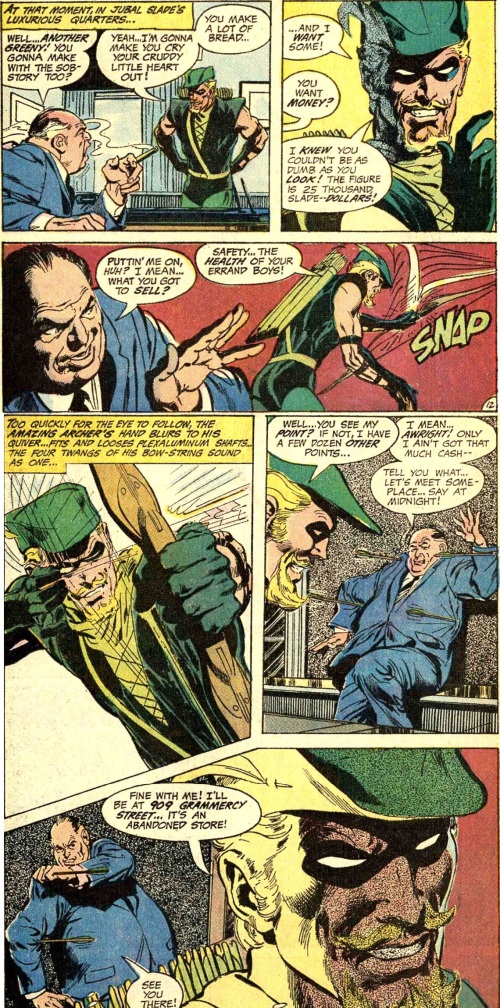






 Cover Artist: Curt Swan
Cover Artist: Curt Swan








 Cover Artist: Nick Cardy
Cover Artist: Nick Cardy







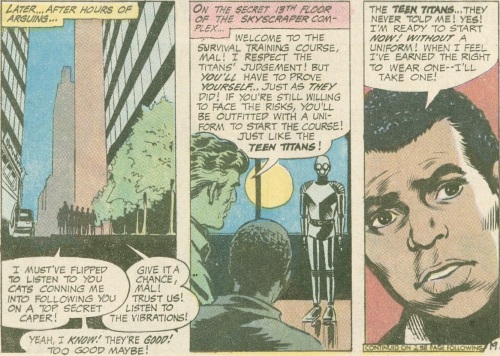







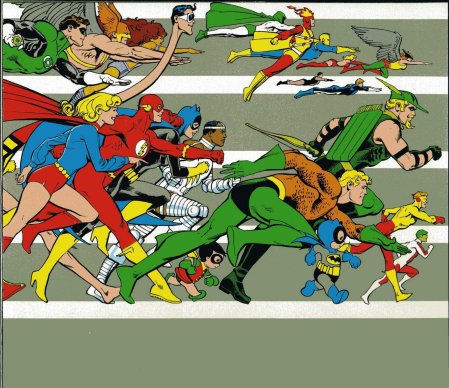
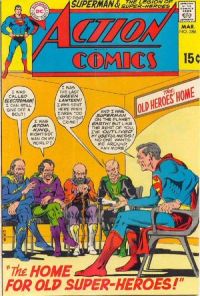
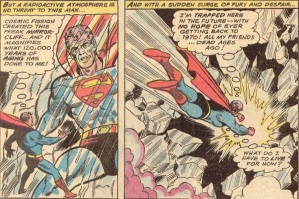
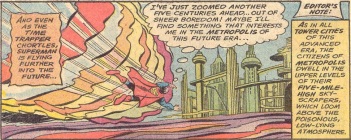
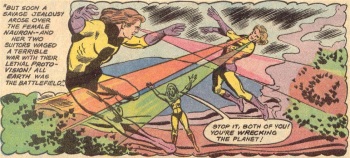
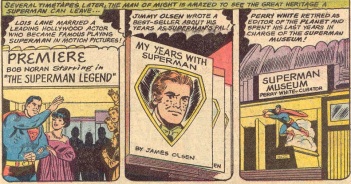
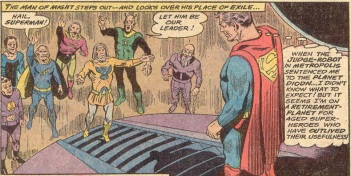


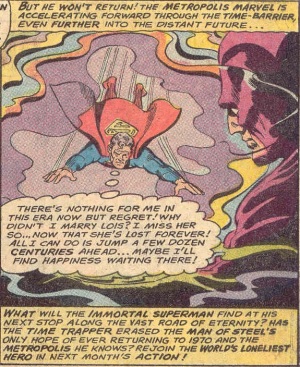

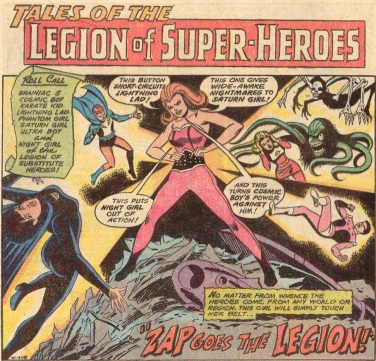
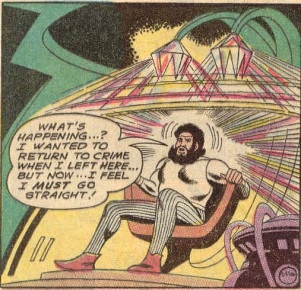
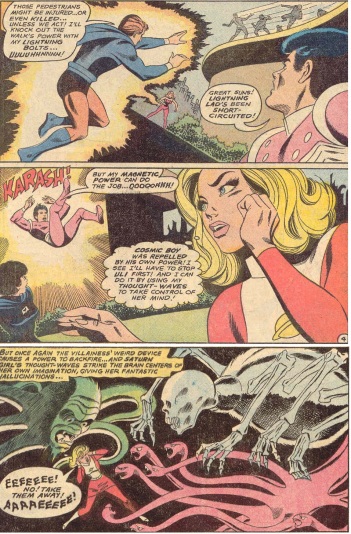
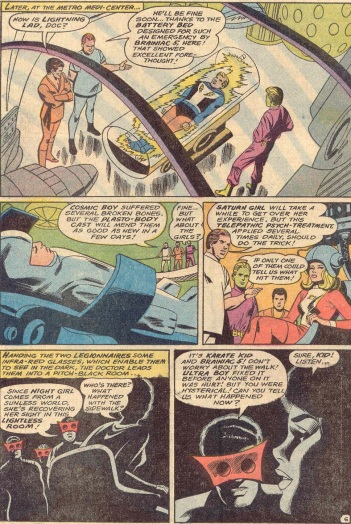

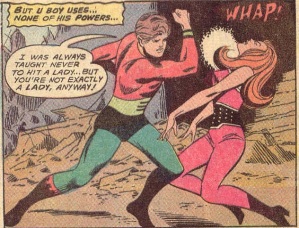
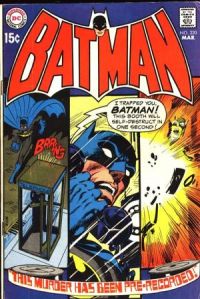
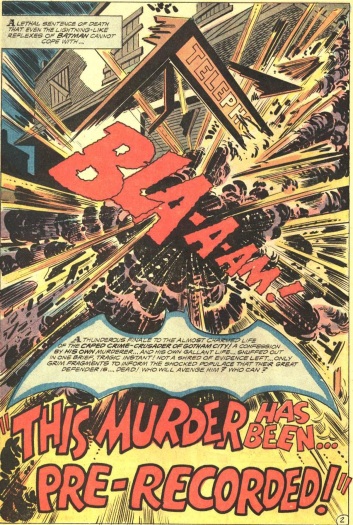

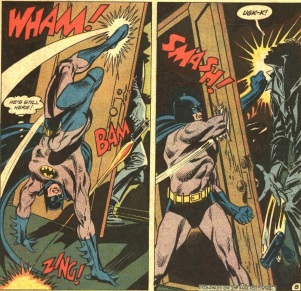
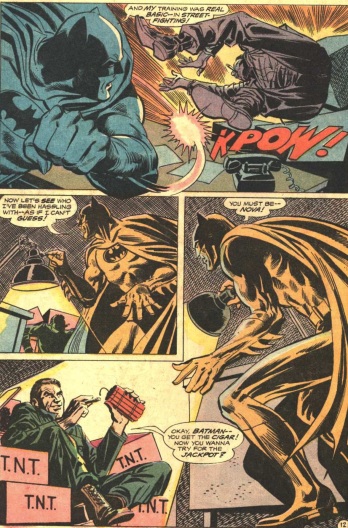


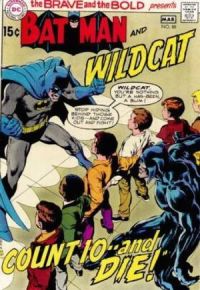

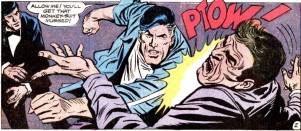
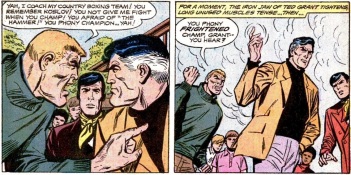
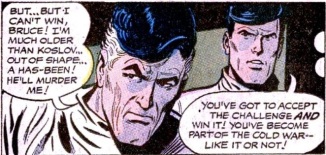
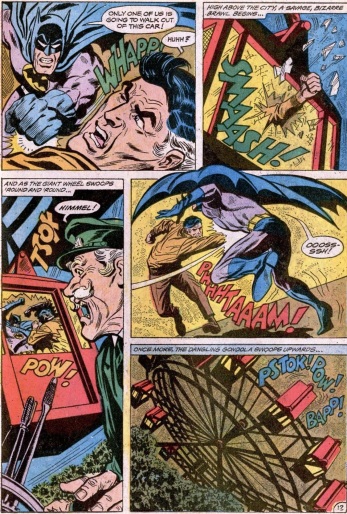
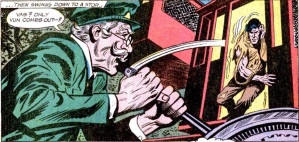
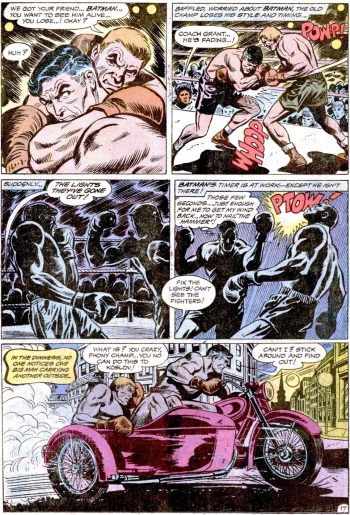
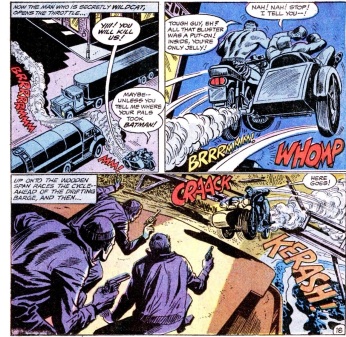
 Then, not even slowing down, Grant ramps the bike off a convenient bridge, runs over a crowd of enemy agents, and frees the Dark Knight. One wonders how the devil he unties those ropes while still wearing boxing gloves, but that’s far from the craziest thing in this story. The two fight their way out, side by side. And, if that weren’t enough, they, with “The Hammer” in tow, race back to the arena, arriving JUST as the lights come back up! Grant has, naturally, carried the unconscious Russian back into the ring just before, and they proceed to continue their fight. All of that happens in THREE pages.
Then, not even slowing down, Grant ramps the bike off a convenient bridge, runs over a crowd of enemy agents, and frees the Dark Knight. One wonders how the devil he unties those ropes while still wearing boxing gloves, but that’s far from the craziest thing in this story. The two fight their way out, side by side. And, if that weren’t enough, they, with “The Hammer” in tow, race back to the arena, arriving JUST as the lights come back up! Grant has, naturally, carried the unconscious Russian back into the ring just before, and they proceed to continue their fight. All of that happens in THREE pages.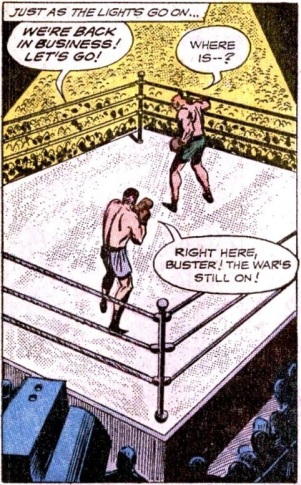

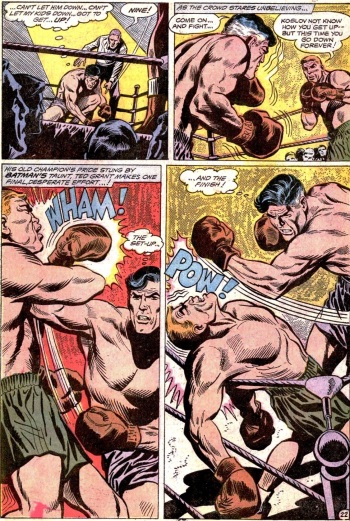
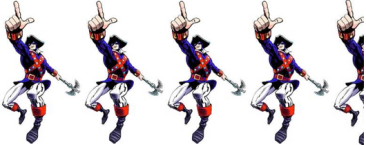














 Wonder Woman runs interference against Willi’s minions who try to ambush Batman’s car along the track, while Bruce pits his skill against Widowmaker’s dirty tricks. It’s a really nice, exciting, quick-moving tale, shifting back and forth between the different perils the heroes face with much the same energy as an actual race. The pacing is very good, and the series of challenges the heroes face is interesting. I’m particularly fond of the ending, which involves Willi being hoisted on his own petard as his henchman springs one of his own traps on his boss. Seconds later, Batman’s beaten, battered racer limps across the finish line. It’s a little bit of poetic justice, and it is a good payoff for the tension of the race.
Wonder Woman runs interference against Willi’s minions who try to ambush Batman’s car along the track, while Bruce pits his skill against Widowmaker’s dirty tricks. It’s a really nice, exciting, quick-moving tale, shifting back and forth between the different perils the heroes face with much the same energy as an actual race. The pacing is very good, and the series of challenges the heroes face is interesting. I’m particularly fond of the ending, which involves Willi being hoisted on his own petard as his henchman springs one of his own traps on his boss. Seconds later, Batman’s beaten, battered racer limps across the finish line. It’s a little bit of poetic justice, and it is a good payoff for the tension of the race.

 Cover Artist: Nick Cardy
Cover Artist: Nick Cardy scientist (in this instance with a super awesome old-timey mustache and chops, plus a sweet cape) stumble upon a plot by spore aliens (because of course) who want to conquer the earth. They defeated the chief alien and his hillbilly cultists (nope, not kidding), and this
scientist (in this instance with a super awesome old-timey mustache and chops, plus a sweet cape) stumble upon a plot by spore aliens (because of course) who want to conquer the earth. They defeated the chief alien and his hillbilly cultists (nope, not kidding), and this issue opens with them stumbling into a small town, which the escaping spore alien has taken over (with the aid of a witch!). The townspeople are forced to serve spore-y, and the Challengers, battered by their previous day’s adventures and on their last legs, are
issue opens with them stumbling into a small town, which the escaping spore alien has taken over (with the aid of a witch!). The townspeople are forced to serve spore-y, and the Challengers, battered by their previous day’s adventures and on their last legs, are  defeated and captured, only to be freed by Red’s little brother (and apparently a singing sensation?), Tino. Apparently a bit has changed between the original issues I read and this point in the series.
defeated and captured, only to be freed by Red’s little brother (and apparently a singing sensation?), Tino. Apparently a bit has changed between the original issues I read and this point in the series. the door was open to bring him back. The new addition, Corinna seems fine, though she doesn’t have much personality. She’s also disturbingly okay with the murder of her father. ‘He’s evil, oh well’ seems to be about the extent of her mourning. I’d keep an eye on her, Challengers. Chances are, she’s a sociopath.
the door was open to bring him back. The new addition, Corinna seems fine, though she doesn’t have much personality. She’s also disturbingly okay with the murder of her father. ‘He’s evil, oh well’ seems to be about the extent of her mourning. I’d keep an eye on her, Challengers. Chances are, she’s a sociopath.

 When I got a bit older, I discovered the best of all Bat-worlds,
When I got a bit older, I discovered the best of all Bat-worlds, 
 That’s the team behind this tale, which is indicative of the good quality of the story and its spooky, mysterious tone. This yarn begins with a nice, moody establishing shot of Batman brooding over two empty graves. He’s in central Mexico, attending an extravagant party of a wealthy and mysterious couple who have a macabre fixation on death, even hosting this party in their own family graveyard. The plot centers around the couple trying to covertly kill an agent of the Mexican government who is investigating them, all while Batman works to save him.
That’s the team behind this tale, which is indicative of the good quality of the story and its spooky, mysterious tone. This yarn begins with a nice, moody establishing shot of Batman brooding over two empty graves. He’s in central Mexico, attending an extravagant party of a wealthy and mysterious couple who have a macabre fixation on death, even hosting this party in their own family graveyard. The plot centers around the couple trying to covertly kill an agent of the Mexican government who is investigating them, all while Batman works to save him. That’s where the tale takes a turn for the strange, as there is a final confrontation in a ruined building where Batman discovers a secret field of flowers, which are apparently madness inducing…and also endow people with immortality. That’s a twist worthy of ‘ol Zany Haney. Still, despite the rapid-fire delivery of the exposition and the strangeness of the concept, it sort of works. The couple, supposedly over a hundred years old, wither and die in moments, falling fittingly into their own, empty graves. Their passing leaves behind a number of unanswered questions, but given the horror flavor of the story, it isn’t as big of a problem as it might seem. This tale evokes the mystical, mysterious feel of the old horror books, where certain questions are left unanswered as part of there overall effect.
That’s where the tale takes a turn for the strange, as there is a final confrontation in a ruined building where Batman discovers a secret field of flowers, which are apparently madness inducing…and also endow people with immortality. That’s a twist worthy of ‘ol Zany Haney. Still, despite the rapid-fire delivery of the exposition and the strangeness of the concept, it sort of works. The couple, supposedly over a hundred years old, wither and die in moments, falling fittingly into their own, empty graves. Their passing leaves behind a number of unanswered questions, but given the horror flavor of the story, it isn’t as big of a problem as it might seem. This tale evokes the mystical, mysterious feel of the old horror books, where certain questions are left unanswered as part of there overall effect.

 This particular tale involves Robin attempting to break up a communist plot (!) involving creating student unrest with fake accounts of police brutality in order to shutdown Hudson University (!). It’s a very 60s style story, and not a terribly interesting one. You have to think that the vague, unspecified commies would have better things to do with their time and money. Nonetheless, Dick manages to break the case open, despite taking a beating and being captured for the second time in two issues. He does manage a fairly nice escape, taking out two guards, all while handcuffed. Still, it isn’t his most impressive showing. I like the idea of having stories with him away in college, but I don’t think all the stories necessarily have to be set ON campus or deal with university matters. It just limits the character way too much.
This particular tale involves Robin attempting to break up a communist plot (!) involving creating student unrest with fake accounts of police brutality in order to shutdown Hudson University (!). It’s a very 60s style story, and not a terribly interesting one. You have to think that the vague, unspecified commies would have better things to do with their time and money. Nonetheless, Dick manages to break the case open, despite taking a beating and being captured for the second time in two issues. He does manage a fairly nice escape, taking out two guards, all while handcuffed. Still, it isn’t his most impressive showing. I like the idea of having stories with him away in college, but I don’t think all the stories necessarily have to be set ON campus or deal with university matters. It just limits the character way too much.


 In a scene ripped from the pages of Around the World in 80 Days, the ever culturally sensitive comic delivers us a tribe of Bedouins who are preparing to burn Akmed’s wife, Princes Azeela, on his pyre in the archaic Indian practice of
In a scene ripped from the pages of Around the World in 80 Days, the ever culturally sensitive comic delivers us a tribe of Bedouins who are preparing to burn Akmed’s wife, Princes Azeela, on his pyre in the archaic Indian practice of 

 He saves her from the pyre, but then what is a good man to do? He agrees to marry her to save her from further retribution at the hands of her people, and we’re given a tender little scene with Jeb comforting Azeela whose husband, let’s remember JUST DIED. The concern on his face, the tenderness of that embrace, is pretty effective at conveying a good deal more than the dialog. Taken all together, that little panel aptly demonstrates the strength of comics as a medium of storytelling. There’s a great efficiency of narrative in that one little combination of image and word.
He saves her from the pyre, but then what is a good man to do? He agrees to marry her to save her from further retribution at the hands of her people, and we’re given a tender little scene with Jeb comforting Azeela whose husband, let’s remember JUST DIED. The concern on his face, the tenderness of that embrace, is pretty effective at conveying a good deal more than the dialog. Taken all together, that little panel aptly demonstrates the strength of comics as a medium of storytelling. There’s a great efficiency of narrative in that one little combination of image and word.



 Writers: Edmond Hamilton and various
Writers: Edmond Hamilton and various